 |
||
|
||
| ||
IntroductionLast time we can rarely hear about a Taiwanese company Silicon Integrated Systems (SiS) - the last news form them were connected with an integrated solution for Socket370 systems - the SiS630 chipset. A year passed but no boards based on it could be actually seen - and it's concerned with the fact that at a comparable price an end-user was choosing among the i810 and the SiS630. What was preferable? A rhetorical question… And even the fact that such top manufacturers as ASUS announced boards based on this chipset, couldn't help this abortive project from SiS, so it was used only for the cheapest motherboards. Such boards were produced by little-known manufacturers whose market's part was very tiny. Board manufacturers spent little money for their products what resulted in weak characteristics of the boards. Apart from it, SiS company was busy with building of a factory what also drew away money from development of new technologies. What will the company be doing now? Well, the only thing to do is to try to get out of such situation. Their attempts to reanimate the 630 chipset with release of new versions - 630E and 630S (where a possibility to use SiS301 - video bridge from SiS was removed, and in the latter they added An AGP 4x slot, one more USB port and ATA100 support) didn't allow the company to receive marked dividends. And now SiS tries to enter budget PC market, and this time they gamble on the system based on Athlon and Duron processors. Such solution represents the first chipset in the world with integrated video system SiS730S for AMD CPU based computers. Such choice was done due to the fact that Duron must have to seize the low PC market segment, and it correspondingly had to have chipsets. For PCs lower than $1000 such solutions were VIA chipsets, but they didn't suit the cheaper computers, since they have to be equipped with an integrated video adapter. SiS have noticed it and decided to gamble on the "all-in-one" solution. 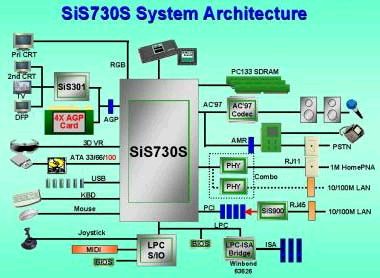 Today their products have no competitors (until release of the VIA KM133). But it's not so simple. Motherboard manufacturers announced the boards for this chipset but it still takes some time to appear on the market. And VIA is not sleeping either: it also launches an integrated solution with a graphics core based on the Savage4, which seems to be more interesting than the SiS300 based graphics. The only thing that attracts is that the SiS chipset is a solution on one chip what should tell upon a board's size; this is especially important, for example, for boards of Flex-ATX format. In my opinion, this chipset will be actually used either for cheap integrated boards or miniature solutions from brands. ChipsetThe most interesting thing in the SiS730S chipset was its release on one chip - the classic chipsets, on the contrary, are based on two chips - a north bridge (works with video card, processor and memory) and a south bridge (data I/O functions) connected by PCI bus (or a special bus). In case of the latest Intel chipsets there are 3 hubs, the two first are the same north and south bridges, and the third one represents a usual chip of Flash-memory. The bus connecting the hubs in Intel solutions has been extended up to 266 Mbps bandwidth, twice exceeding PCI characteristics. The V-Link bus that connects two chips in the latest VIA chipsets, has the same bandwidth. And what's about SiS? They avoid some limitations by integrating two chips in one. Although it doesn't widens a bus between the conditional bridges, it gives possibility to connect directly an IDE controller and a north bridge. No secret that exactly this connection was of the greatest importance for modern chipsets, since IDE devices because of increasing bandwidth of their channel (in case of the ATA100 - up to 100mbps) laid the main load on the bus while exchanging of data between north and south bridges, what with PCI bandwidth didn't leave a place for other devices. Intel, AMD and others have taken another way - they created a wide bus, and as for SiS, they didn't need to build a broadway instead of a narrow path, and it was thanks to the chipset design in the form of one chip. 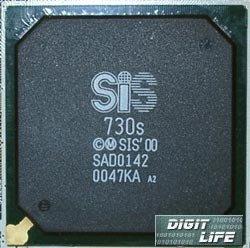 Specifications:
As you can see, the set of supported functions distinguishes this chipset out of the rows of other competitors. Let's see whether it can prove its might. Unfortunately, we couldn't test the VIA KM133 since we do not have a board on it, but we were able to compare the chipset with other integrated solutions. I'd like to mark out of the listed specs a built-in video adapter - an already known solution based on the SiS300. Unfortunately, the company didn't replace it by a more modern SiS315, thus leaving us with rather low speed in 3D. In the previous tests we showed that this solution didn't allow using it in up-to-date graphics applications, due to low speed and definite problems in the software - particularly in API OpenGL. Although 2D image is quite good, we can't call the SiS300 a successful choice. Nevertheless, the chipset is intended for the value market sector. BoardThe first board offering an integrated solution for Socket462 (Socket A) was Asus A7S-VM. The board itself is a sample. 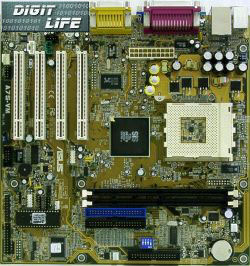 Board specifications:
The technical characteristics of the boards are wider than that of the reference design of SiS boards - in particular, the board lacks for AGP, ACR slots, but it has two more PCI slots. The layout is actually not very competent - a position of CD-in and AUX-In connectors in front of PCI-slots doesn't always provide an easy access, power supply connector is located between a socket and a rear panel, and in some cases it will be accessed with difficulty because of a power supply unit in the way. The BIOS is based on the AWARD 6.0 and contains the wide range of settings. It's version, though, was 1001 beta 006 - not even a release, that's why everything can change yet. A possibility to change multipliers manually was a pleasant feature, but this function turned to be unworkable. There is a wide range of frequencies to choose: 45-60, 48-48, 90-90, 100-66, 100-100, 100-133, 100-150, 100-165, 103-103, 103-137, 104-139,105-105, 105-157, 110-110, 111-166, 112-112,124-124, 125-100, 133-100,133-133,137-103, 137-137, 138-138, 140-140, 150-150, 166-166, 200-200. The first figure means FSB frequency, the second stands for memory speed (AGP and PCI frequencies do not overstep the limits of 70 and 35 MHz, correspondingly). Besides, there is offered a wide choice of memory settings - and the only thing missed for an overclocker is a possibility to increase core voltage. As for stability, I could only mention that the system gave out failures rather often, and then hung. But we should mention once again that it was not a production board, but a sample. PerformanceSpeed characteristics were defined in comparison with the systems of the same level, and we were aimed at the VIA KM133 releasing right after the SiS730S. That's why we tested PM133 based board which contained Savage4 core and was intended for the systems with Socket 370, and the KT133A together with a video card based on the Savage4 Pro. The test configuration:
Software:
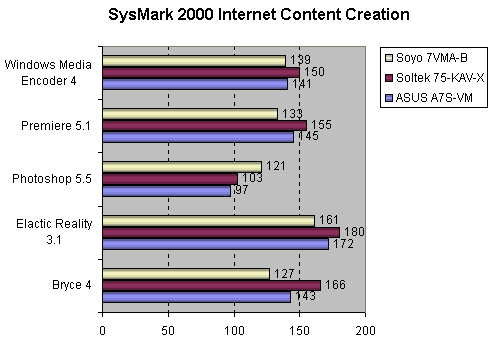 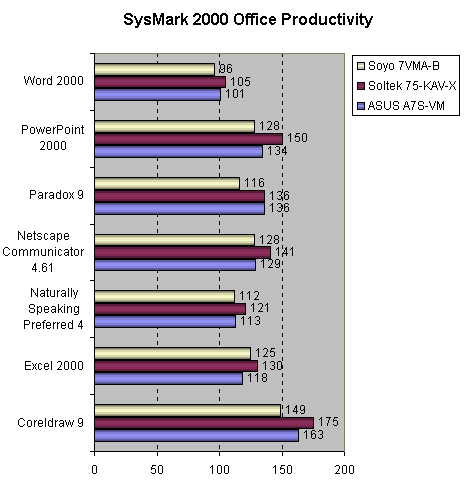  In the BIOS Setup you can set a volume necessary for a system memory's video adapter, and I tested all possible modes in Quake3. Since the system hung I couldn't obtain the result at 1024X768X32bit on the A7S-VM board when setting 8 MBytes memory. As you can see the results are not very attractive. In business applications the SiS730S ran not so bad as compared with the PM133. In Quake3 it was an integrated video adapter that lets it down. Final wordsThe direct competitor of the SiS730S will be of course the KM133 chipset - and on the example of the KT133, which has a similar architecture with the KM133, we can see that the struggle of Socket 462 (Socket A) boards in the low market sector won't be so bloody. Considering the price of $39 for the SiS730S I can't state that this chipset will draw a fantastic attention of many board manufacturers. But SiS is still mighty to come ahead - their new chipsets - SiS635 and SiS735 are coming (with DDR SDRAM support for Socket370 and Socket462, correspondingly), and if the new chipsets will be attractive in terms of price or performance, then... Write a comment below. No registration needed!
|
Platform · Video · Multimedia · Mobile · Other || About us & Privacy policy · Twitter · Facebook Copyright © Byrds Research & Publishing, Ltd., 1997–2011. All rights reserved. |